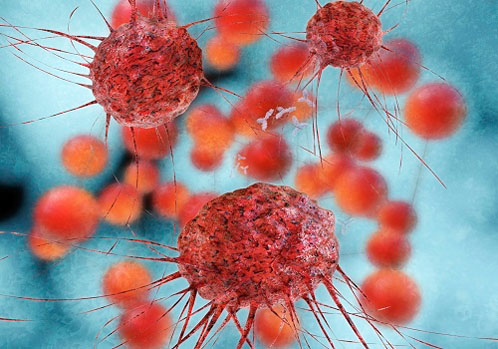More than 80 years later, methods to detect and visualise proteins in biological samples continue to advance, driving the discovery and development of novel therapies and diagnostics. New capabilities empower researchers to gain deep, high-resolution insights into biological processes and disease markers.
Researchers now have a vast array of options to characterise the proteins present in tissues; but, with a broader spectrum of available methods comes the challenge of selecting the right tools for the appropriate level of analysis.
Even with more powerful tools than ever before, the most advanced technology isn’t always the best fit for your specific research question.
In this article, Pam James, PhD, Vice President, Product, Vector Laboratories, discusses some key considerations in terms of choosing protein detection and visualisation methods for therapeutic and diagnostic development and biomarker discovery.
Fundamental immunostaining techniques and applications
Immunostaining is a go-to method throughout basic science, clinical research and diagnostic labs, allowing scientists to detect and localise specific proteins within a biological sample.
Using detection systems based on enzymatic colour deposition (for immunohistochemical [IHC] techniques) or fluorescent signals (in the case of immunofluorescent [IF] techniques), researchers and pathologists can target a protein of interest and observe its distribution throughout a cell or tissue sample.
Although it seems basic compared with novel techniques, conventional IHC is still foundational to drug development and clinical workflows … and remains the gold standard for clinical pathology.
When designing an IHC assay, the anticipated expression level of the target antigen is a key consideration that can impact the choice of labelling approach. Although direct detection methods involve a simpler more efficient workflow, indirect detection methods can help to amplify signal intensity for low-abundance protein targets.
The need to detect multiple targets can also impact user decisions, as distinguishing more than three chromogens in a single slide can be difficult in traditional IHC — particularly when the targets are colocated. Even if multiple target detection is necessary, two or three-colour IHC is strong and sensitive enough to preclude the need to implement more complex multiplexing methods.

The method is reliable and cost-effective, making it a suitable choice for therapy guiding assays used in clinical trials. IF can easily and clearly detect three to four markers in a single tissue section and has the advantage of being able to detect colocalisation of targets. Indirect methods of detection are easily facilitated with the many high-quality robust detection reagents available from reputable suppliers.
Direct methods of detection are more challenging owing to the limited sensitivity and availability of fluorescently labelled primaries that have been validated for tissue-based assays. Fortunately, new approaches and tools for bioconjugation have simplified the process of creating custom bioconjugates for research needs with hapten tags, fluorescent dyes and more, expanding the toolbox available for assay development.
Sequential staining is also an option for researchers looking to detect multiple targets while still using conventional IF techniques. In this method, tissues are stained with IF and imaged.
After imaging, the first round of IF is stripped and the process is repeated. The resulting images are then digitally overlaid. Using this method, 10 or more targets can be detected in a single tissue section.
Advances in reagents that ensure the complete removal of antibodies while preserving the integrity of precious tissue samples have improved the efficiency, reliability and reproducibility of this approach.1
In any case, immunostaining assays can require significant troubleshooting and optimisation to ensure consistency and reproducibility.
A review of data from the Human Protein Atlas suggests that at least half of the 2500 commercially available antibodies tested did not perform as expected when used in assays, highlighting the importance of validated, high-quality antibodies from reputable suppliers or thorough validation by the user in immunostaining applications.2
Improvements in other essential components of the immunostaining workflow and increased awareness of important variables, such as optimal tissue fixation approaches, have also increased the reliability of these methods.
An often-overlooked component of traditional IHC and IF assays is the choice of the mounting media; this is contingent on several factors, including ultimate sample storage needs.
For example, the storage conditions of archived samples, susceptibility of fluorescent dyes to photobleaching and compatibility of chromogens with aqueous and non-aqueous mounting media can all impact this selection.
When developing an assay, it’s important to consider these factors, taking time to troubleshoot and internally validate methods to ensure that any antibodies used are specific to the target of interest.
Delivering clear, interpretable images is also essential to reliable assay development. The automated analysis of IHC/IF images has become more commonplace, helping to standardise measurement and overcome issues of inter-observer variability … but good staining methods are central to achieving good results.
Integrating multiplex IF methods into experiments
Multiplex IHC and IF capabilities have dramatically expanded in recent years, overcoming some of the challenges and limitations of using conventional immunostaining to detect multiple biomarkers in a single slide.
These developments have helped to achieve more detailed and accurate data about the spatial distribution of key biomarkers in health and disease, allowing researchers to obtain more insight than ever from precious tissue samples.
Multiplexing has been especially valuable in preclinical and early stage or retrospective clinical trials. In these settings, investigators have more flexibility when assessing a panel of candidate biomarkers that may be relevant to a disease or treatment mechanisms rather than taking a more focused biomarker approach in later-stage trials.
Advances in the application of dye chemistry have been a driver of multiplex IF capabilities. One example is tyramide signal amplification (TSA). A user introduces tyramide-conjugated fluorophores to a sample incubated with an enzyme-conjugated secondary antibody, producing a reaction that ultimately results in the covalent attachment of the fluorophore to the tissue at the site of the target.
After the antibodies are removed, the user can perform additional rounds of binding and TSA with other fluorophores and then image.
The development of TSA-based IF methods that have been optimised for multiplexing has enabled the routine detection of four or five markers on a single slide, and advanced multispectral imaging technologies can support 6- to 8-plex IF assays using spectral unmixing.3
However, developing an advanced multiplex panel is a significant investment that’s only suitable for some research applications. The process can take months of development and validation, which may not be ideal if the assay is needed immediately or intended for a one-off colocalisation study.
In these instances, working with a contract research organisation (CRO) with established experience in the method can help to avoid these challenges and eliminate the arduous process of workflow development and validation.

Even newer modalities using antibodies conjugated to oligonucleotide “barcodes” have also emerged that dramatically increase the number of targets detected on a single slide.4
These methods offer promise for the deeper exploration of colocalisation and distribution of biomarkers in disease research. Importantly, not all DNA barcoding-based IF platforms are equally suitable for research and clinical applications.
Although some platforms require highly specialised instrumentation and complex workflows, limiting their direct applicability to current clinical labs, others can achieve multiparametric imaging using a standard three-colour fluorescence microscope.5
Exploring the tumour microenvironment
How can these innovations in protein detection and visualisation translate to advancements in the development of diagnostics and therapeutics? One prime example is the utility of these methods to characterise the tumour microenvironment (TME).
The TME is a complex and dynamic milieu of cells, blood vessels, signalling molecules and immune cells surrounding a tumour. It plays a critical role in influencing tumour behaviour, growth and response to therapy, making the TME a fertile research area in which to identify relevant biomarkers.6
Advanced protein visualisation techniques in this spatial context enable scientists to achieve a more in-depth understanding of the distribution and interaction of different populations of immune cells and other key markers within the TME.
Characterising the complex immune landscape surrounding a tumour helps researchers to understand how the immune system interacts with the cancer and informs the development of more effective immunotherapies.
Researchers and clinicians can leverage these data to inform the development of novel drugs and appropriately select treatments that are tailored to a patient’s unique cancer biomarkers.
Continued refinement of the reliability, accessibility and throughput of multiplex IF methods will contribute to developing diagnostic panels that can be more easily applied in clinical labs.
Advances in other techniques for the spatial analysis of proteins and other molecules, such as proximity ligation assays (PLAs), are also valuable additions to the mission of understanding cancer drivers and selecting treatments.
For example, a preliminary study validated a novel assay combining multiplex IF with PLA to identify the direct interaction of PD-1 and PD-L1 within the context of the wider immune microenvironment.7
A growing body of research has also implicated altered glycans as a potentially useful biomarker and target for cancer therapies.8 The availability of labelled lectins and antiglycan antibodies for imaging has enabled coexpression studies to be done with proteins and specific glycans in the TME.
However, the study of glycosylation in this context requires the complex nature of glycans to be considered. Using well-validated lectins and antibodies is vital to achieving the clear visualisation of protein expression and glycosylation in tissues.
For such experiments, working with suppliers and collaborators with deep experience and knowledge in glycobiology research can greatly simplify assay development.
Looking ahead in protein detection and visualisation
Advances in protein visualisation and detection methods have emerged as pivotal drivers of progress in unravelling the complexities of cancer progression, metastasis and other biological processes.
Understanding the dynamic interactions between various cell types and signalling pathways within the TME is crucial for the development of more precise cancer diagnostics and targeted therapies.
This comprehensive characterisation facilitates the identification of specific biomarkers associated with disease progression, immune evasion and treatment response.
Continued dedication to the standardisation, validation and improvement of methods, as well as more advanced methods to analyse complex images will be essential to drive research progress forward.
However, as methods continue to advance, researchers are faced with a range of options for protein detection and localisation. The newest, most advanced technologies aren’t right for every application … and conventional IHC is still the gold standard for clinical pathology.
Whether developing an assay in-house or selecting an established assay for your research, choosing the right tool for your research question, resources and capabilities can make a significant difference in the efficiency and success of your lab’s workflows.
References
- https://vectorlabs.com/blog/adding-efficiency-and-convenience-to-multiplexingworkflows/.
- www.mcponline.org/article/S1535-9476(20)31283-4/fulltext.
- www.modernpathology.org/article/S0893-3952%2823%2900102-3/fulltext.
- www.ncbi.nlm.nih.gov/pmc/articles/PMC7170662/#cac212023-bib-0001.
- www.ncbi.nlm.nih.gov/pmc/articles/PMC6086938/.
- www.cell.com/cancer-cell/pdf/S1535-6108(23)00044-2.pdf.
- https://aacrjournals.org/cancerres/article/83/7_Supplement/4336/720710.
- www.ncbi.nlm.nih.gov/pmc/articles/PMC8870586/.
